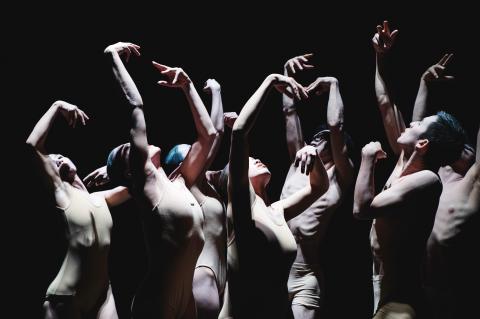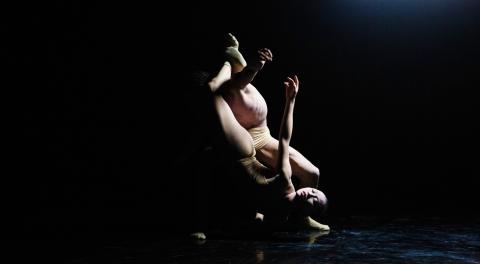Lai Hung-chung (賴翃中) graduated from the School of Dance at Taipei National University of the Arts (TNUA, 國立臺北藝術大學) in 2012, but just five years later he founded his own dance company, Hung Dance (翃舞製作) after racking the first of a series of wins at international choreographic competitions.
It was at one of those events in Germany, the International Choreographic Competition Hannover in June 2107, that he met Spanish dancer/choreographer Mario Bermudez Gil, a five-year veteran of the Batsheva Dance Company in Israel, who had founded his own company, Marcat Dance, with his American partner Catherine Coury the year before.
While Hung’s duet, Watcher (守), took both 3rd place and the Critics Award in Hannover, Gil was not so lucky with his duet Alanda, but the two men liked each other’s pieces and the seed for a future collaboration was planted.

Photo courtesy of Terry Lin
However, as a dancer Gil still ended 2017 on a high note, being named as one of Dance Magazine’s “25 to Watch,” and he has gone on to create works for the National Company of Spain, the National Company of Wales, Scapino Ballet Rotterdam and flamenco star Eva Yerbabuena, in addition to several pieces for his own troupe.
Now Hung Dance can be added to that list, as the company premiers Gil’s latest work, Out of Elegant (優雅之外), at the National Experimental Theater in Taipei this weekend.
The show marks the start of what Lai hopes will be a long line of collaborations with international choreographers, and he said it is one of his most anticipated projects, which is saying something, since last month Hung Dance launched its Stray Birds Platform (漂鳥舞蹈平台) at the Taiwan Traditional Theatre Center’s Experimental Theater to showcase the works of young Taiwanese choreographers and dancers.

Photo courtesy of Terry Lin
Lai said Out of Elegant, set on seven dancers to a score by Jose Pablo Polo, is the story of creatures, perhaps from a distant land or another planet, who are struggling to survive in unfamiliar terrain.
Gil’s goal was to create a unique movement language specific to this piece that would allow each dancer to explore their body and physicality, Lai said.
Unlike Lai, Gil did not start studying dance until he was 20, but after studying at the Andaluz Dance Center in Seville, Spain, he moved to New York City to work with the Galin Dance Company for two years before relocating to Tel Aviv to join Batsheva.
That he and the 32-year-old Gil come from different cultures and have very distinct dance styles and philosophies was one of the reason’s he wanted to invite him to create a full-length work for his troupe, Lai said.
Gil’s choreography is known for its dynamic physicality and deep emotional impact.
Lai said that he hoped Gil’s style of physical training and dance presentation would help his dancers gain a more multifaceted technique.

On April 26, The Lancet published a letter from two doctors at Taichung-based China Medical University Hospital (CMUH) warning that “Taiwan’s Health Care System is on the Brink of Collapse.” The authors said that “Years of policy inaction and mismanagement of resources have led to the National Health Insurance system operating under unsustainable conditions.” The pushback was immediate. Errors in the paper were quickly identified and publicized, to discredit the authors (the hospital apologized). CNA reported that CMUH said the letter described Taiwan in 2021 as having 62 nurses per 10,000 people, when the correct number was 78 nurses per 10,000

As we live longer, our risk of cognitive impairment is increasing. How can we delay the onset of symptoms? Do we have to give up every indulgence or can small changes make a difference? We asked neurologists for tips on how to keep our brains healthy for life. TAKE CARE OF YOUR HEALTH “All of the sensible things that apply to bodily health apply to brain health,” says Suzanne O’Sullivan, a consultant in neurology at the National Hospital for Neurology and Neurosurgery in London, and the author of The Age of Diagnosis. “When you’re 20, you can get away with absolute

May 5 to May 11 What started out as friction between Taiwanese students at Taichung First High School and a Japanese head cook escalated dramatically over the first two weeks of May 1927. It began on April 30 when the cook’s wife knew that lotus starch used in that night’s dinner had rat feces in it, but failed to inform staff until the meal was already prepared. The students believed that her silence was intentional, and filed a complaint. The school’s Japanese administrators sided with the cook’s family, dismissing the students as troublemakers and clamping down on their freedoms — with

As Donald Trump’s executive order in March led to the shuttering of Voice of America (VOA) — the global broadcaster whose roots date back to the fight against Nazi propaganda — he quickly attracted support from figures not used to aligning themselves with any US administration. Trump had ordered the US Agency for Global Media, the federal agency that funds VOA and other groups promoting independent journalism overseas, to be “eliminated to the maximum extent consistent with applicable law.” The decision suddenly halted programming in 49 languages to more than 425 million people. In Moscow, Margarita Simonyan, the hardline editor-in-chief of the